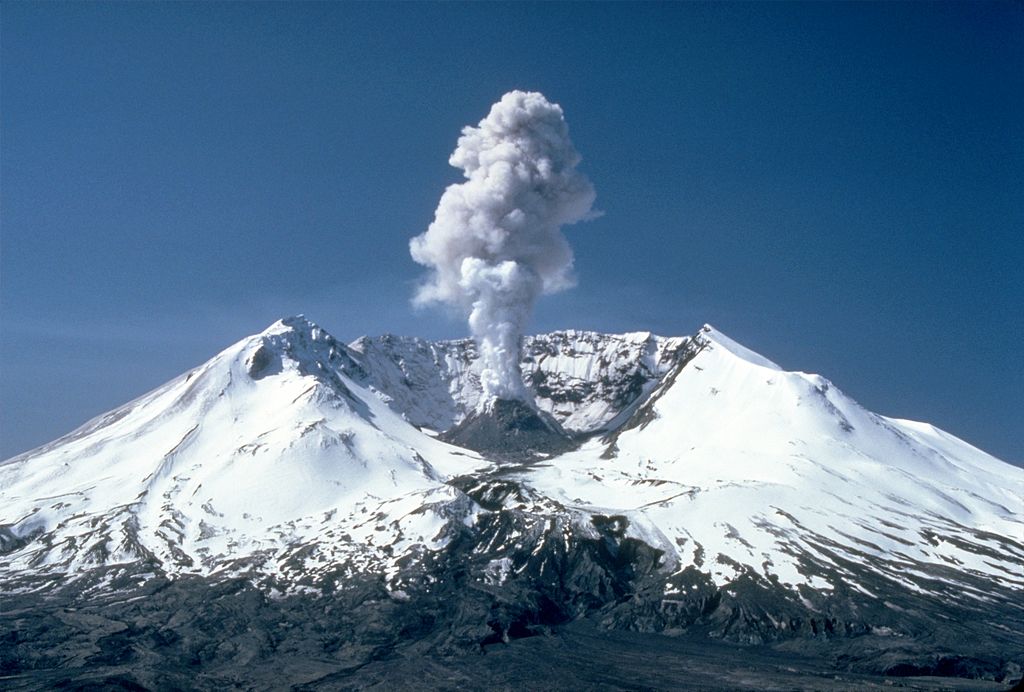Interesting facts about Mount St. Helens epic eruption

Mount St. Helens is an active volcano in Scamanina County, Washington, only 96 miles south of Seattle and 5o miles northeast of Portland. The volcano got its name from the British diplomat Lord St. Helens, a friend of the explorer George Vancouver, who did an expedition in the area in the late 18th century. Mount St. Helens is a part of the Cascade Volcanic Arc which joins the Pacific Ring of Fire.
The volcano had its most recent major eruption in 1980. It was the deadliest and the most destructive volcanic eruption in the history of United States, causing the death of 57 people. 250 homes, 47 bridges, 15 miles of railroad and 185 miles of highway were destroyed.

- Mount St. Helens is the most frequently erupting volcano in the Cascade Range during the past 4,000 years.
- Native Americans witnessed an eruption of Mount St. Helens around 3,600 years ago that was four times bigger than the one on May 18th, 1980.
- The United States Geological Survey in 1975 predicted that the volcano will erupt again by the end of the century.
- An earthquake with a magnitude of 4.2 on March 20, 1980, announced the awakening of the volcano after 123 years of inactivity.

- The summit was reduced 1,300 feet in the landslide.
- Within 3 minutes, the lateral blast, traveling at 300 miles per hour, blew down 230 square miles of forest.
- Within 15 minutes, the volcanic ash rose over 80,000 feet.
- In the afternoon on the same day, the dense ash turned the day into night in Washington.
- The ash cloud moved across the States in the next three days and circled the whole planet in two weeks.
- Volcanic mudflows filled the rivers with stones and sand, damaging 47 bridges.
- Tiny plants and trees that were covered by the winter snow survived the eruption, and they’re still thriving today.

- Thousands of mammals, birds, reptiles, and amphibians were wiped out in an instant.
- Scavenging beetles and spiders were the first species that got back to Mount St. Helens after the disaster. These insects were brought into the area by the wind.
- The effects from May 18, 1980, eruption are still visible today. Biologists today transport salmon from the sediment-choked rivers into pristine creeks in the higher parts of the Mount.
- Explosive eruptions on May 25, June 12, July 22, August 7, and October 16–18 rocked Mount St. Helens later the same year.
- The Mount St. Helens National Volcanic Monument was established on August 27, 1982, by U.S. President Ronald Regan as a memory of the devastating volcano and the recovery from its destructive power.
- Since 1986, snow and rock accumulating in the deep crater formed Crater Glacier, the youngest glacier on our planet.
- From September 2004 to January 2008 Mount St. Helens erupted continuously.
- Mount St. Helens is one of the world’s best places for studying Earth’s processes and volcanic activity.

Mount St. Helens is of extraordinary significance for the Native American tribes from the region. According to their legend, there were two brothers Pahto and Wy’east, sons of the chief of all gods. They were traveling down Columbia River in search of the most beautiful land. Eventually, they reached the area that’s now called The Dalles and started a quarrel about who’s going to settle first.
Their father, the chief of gods, shot two arrows to give them separate directions. Pahto followed the arrow to the north and settled there while Wy’east followed the arrow to the south. Their father built the Bridge of Gods so they can meet whenever they want. The two brothers fell in love with the same maiden named Loowit, and she couldn’t decide which one she prefers. They fought over her so brutally that they destroyed the bridge. As a punishment, their father turned the three of them into mountains. Wy’east was transformed into today’s Mount Hood, Pahto was turned into Mount Adams, and Loowit became Mount St. Helens.

If you have any comments then please drop us a message on our Outdoor Revival Facebook page
If you have a good story to tell or blog let us know about it on our FB page, we’re also happy for article or review submissions, we’d love to hear from you.
We live in a beautiful world, get out there and enjoy it. Outdoor Revival – Reconnecting us all with the Outdoors.
